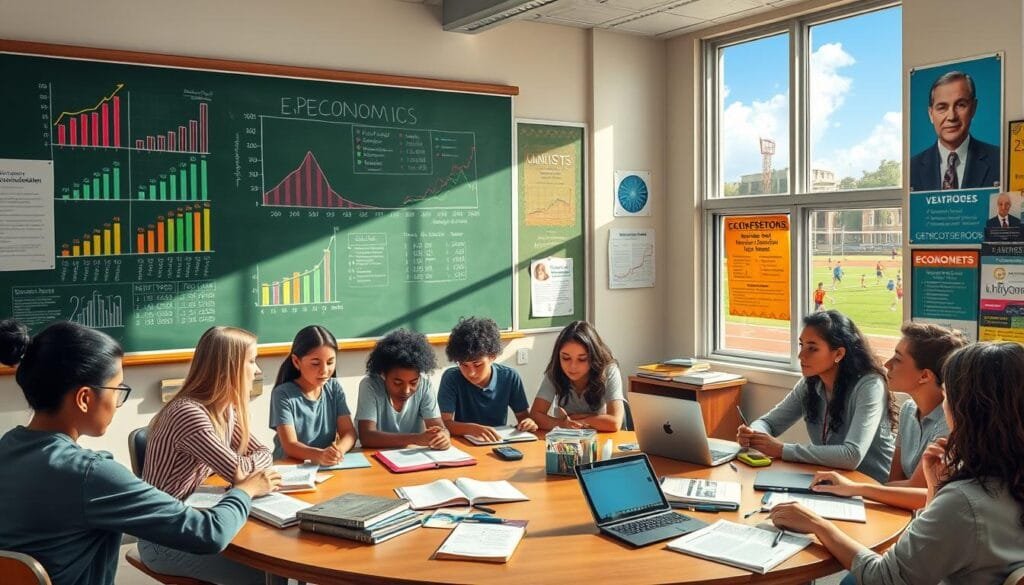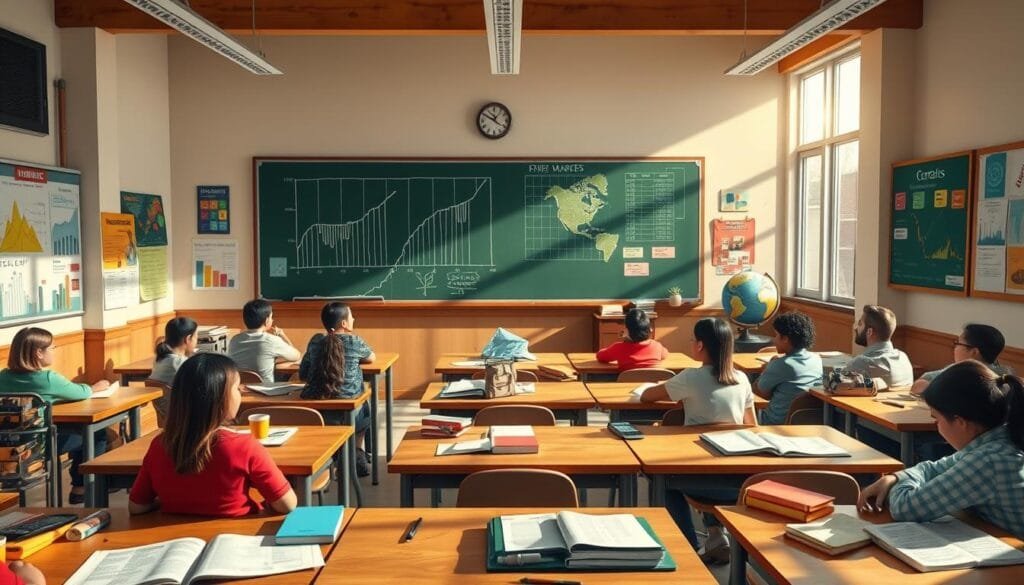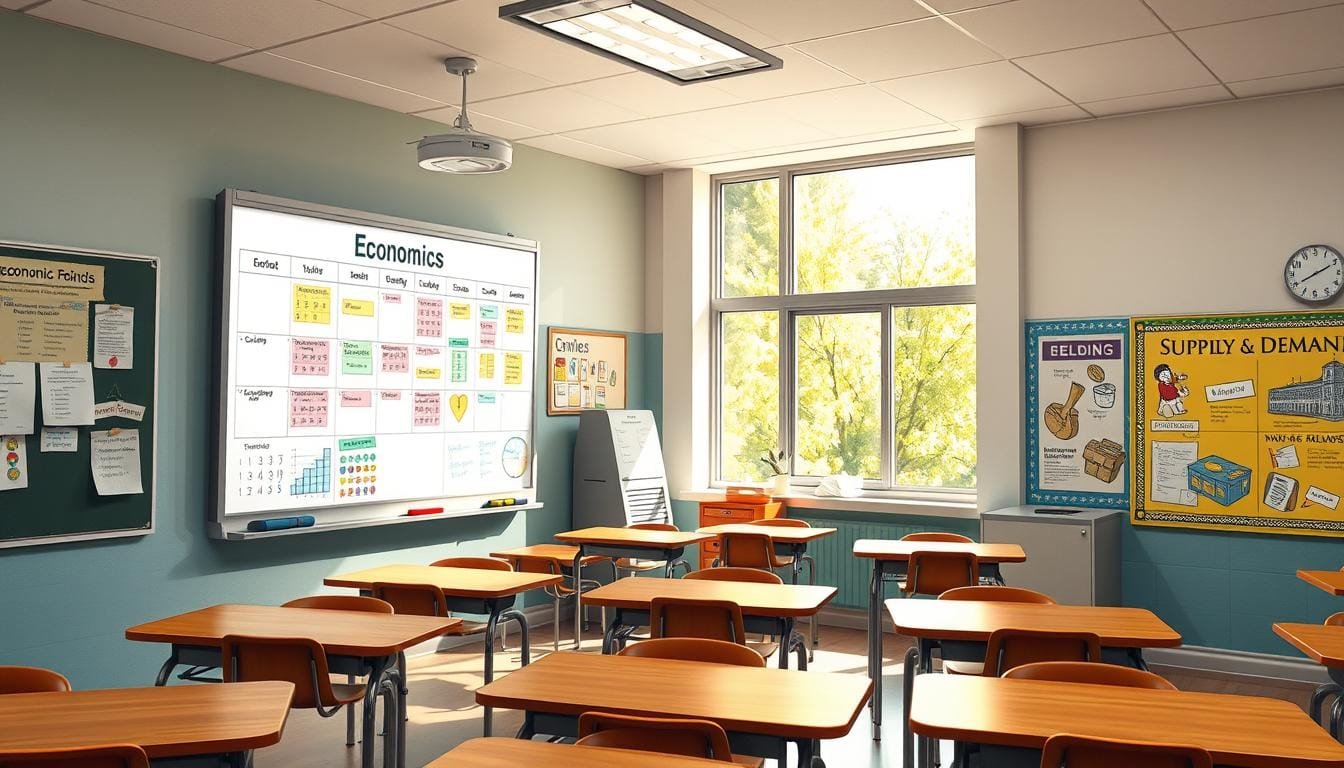Have you ever thought about how the timing of your economics class affects your learning? Finding the best schedule for economics is crucial for academic success. It’s about more than just fitting a class into your day.
Economic principles are vital in understanding current events and making personal finance decisions. It’s important to figure out the best time to study economics from freshman to senior year. This can greatly impact understanding and application. But how do states decide when to teach economics? Recent studies show that adjusting schedules and curriculum is key in education debates.
Key Takeaways
- The timing and scheduling of high school economics classes can significantly affect students’ grasp of economic concepts.
- Optimizing the high school economics schedule involves balancing timing and integration with real-world applications.
- As of 2024, more than two-thirds of U.S. states mandate personal finance classes for high school graduation, impacting over 10 million students.
- Thirty-five states currently require a course in personal finance for graduation, showing a notable increase from 2022.
- In 2024, 28 states will require some study of economics in high school, reflecting a growing emphasis on economic education.
The Importance of Economics in High School Curriculums
Economics is key in helping students understand money and society. High school economics is crucial but varies across states. Some states have strong economics teaching, while five do not require it at all.
State Requirements and Standards
State standards aim to teach students basic economic principles. Yet, there’s uneven application across states. Some states include it well in their curriculum, but others don’t emphasize it as much.
A study showed economics courses boost financial literacy by 67%. This leads to better budgeting. Another study found that it improves critical thinking by 25%. It also enhances problem-solving.
About 60% of students felt more involved in their communities. They felt ready to discuss public policies. But, only 40% of teachers feel prepared to teach economics. This shows the need for better teacher support.
Integrating Economics with Other Subjects
Mixing economics with other topics can improve learning. It helps students see economic ideas from different angles. This makes learning more engaging and useful for them.
- Interdisciplinary learning boosts understanding of global issues. About 75% of students see economics as vital for global knowledge.
- In places where economics is required, more students choose business-related majors. This shows economics influences career paths.
- 55% of students think economics in their courses would make learning better. They believe it wouldn’t be too much work, showing they are open to this approach.
To wrap up, economics in high school teaches students about real-life economic challenges. It’s essential in education standards. Also, teaching it with other subjects makes for a richer education.
When Can You Take Economics in High School
Knowing when to take economics in high school is key. It helps students make the most of their learning. High school economics gives basic knowledge and skills needed for the future. We’ll look at when these courses usually happen, and what you need before starting.

Typical Grade Levels for Economics Classes
Economics is often taught to 11th and 12th graders. This setup lets students learn other subjects first. It’s important to start economics early in high school. This way, students are ready for college and whatever comes next.
- 11th Grade: A critical period for introducing students to the principles of economics.
- 12th Grade: Often involves more advanced economics courses, including AP Economics options.
Prerequisites and Corequisites
Before starting economics, students usually need to take certain classes. These include social studies and math, with a big focus on calculus. Knowing this helps students plan their high school journey.
| Prerequisite | Reason |
|---|---|
| Social Studies | Provides foundational knowledge in history and geography essential for understanding economics. |
| Mathematics | Ensures students have the analytical and problem-solving skills necessary for economics. |
| Calculus | Often mandatory for advanced economics courses due to the quantitative nature of the subject. |
About 70% of business programs need calculus. Students who take it in high school do better in college economics. Plus, calculus on a high school transcript impresses college admissions.
Balancing Economics and Personal Finance Coursework
High schools strive to balance economics and personal finance in their courses. This blend is crucial yet hard to achieve. It allows students to learn necessary skills for financial decisions.
California high schoolers have a hefty course load with 13 required subjects including English and math. By the 2030-31 school year, they must also take a semester in personal finance. This lets them skip the usual economics semester.
It’s vital to balance these subjects for a solid education. Seniors in California must take at least five courses each semester. Still, exceptions exist for foster or homeless students, helping them graduate on time.

This strategy readies students for college and careers. Understanding economics and managing personal finances are key skills. Schools might offer advanced studies and practical work experiences for interested students.
From the 2029-30 school year, students also need an Ethnic Studies semester. This adds to their required courses, making it necessary to manage their coursework carefully.
The aim is to deepen knowledge in economics and personal finance. With more states requiring finance education, its value is clear. Educators play a crucial role in preparing students for future financial challenges.
For information on Wisconsin’s Personal Financial Literacy Standards, check the official document. It outlines how to prep students for financial success.
Online vs. In-Person Economics Classes
Economics is becoming more important in high school. Students and teachers have to make a big choice. They need to decide between online and in-person classes. This decision is crucial as we look into the pros and cons of traditional vs. online learning for high school students.
Benefits of Online Economics Courses
Online economics classes are very flexible. They let students learn in a way that fits them best. They can study at their own pace. Students have access to many resources. Coursera and YouTube offer free courses. This means students can start learning without paying anything. More than 2,600 high schools use MRU resources. This shows how effective online tools are at improving economics education.
| Key Benefits | Statistics |
|---|---|
| Flexibility in Learning | 45% of online students like the flexible schedule |
| Cost-Effective | Coursera offers many free courses |
| Wide Adoption | Over 2,600 high schools use MRU |
Students find online classes easier and less work than in-person ones. They have more freedom to choose when to do their work. This is different from the tight deadlines in traditional classes.
Challenges of Traditional Classroom Settings
In comparing traditional vs. online learning, the latter often seems more flexible. Yet, in-person classes have their own advantages. They offer a structured setting and chances for interaction. This is key for understanding complex topics. For instance, 70% of students in traditional classes learned more through group work and discussions.
| Key Challenges | Statistics |
|---|---|
| Early Class Timing | Students might skip early morning classes |
| Engagement Issues | 58% of teachers think in-person classes engage students better |
| Understanding Complex Concepts | 45% of online students struggle without face-to-face help |
Traditional classes often lead to higher grades. Students get a grade average of 3.2 out of 4.0. Engaging with real-life examples in class helps students do better.
Choosing the Right Economics Curriculum
Choosing the right economics curriculum for high school students is very important. It affects their education and future jobs. It’s key to mix lessons on micro and macroeconomics with real-life economic theory uses.
Microeconomics vs. Macroeconomics
It’s vital to know the difference between microeconomics and macroeconomics to help students. Microeconomics looks at the economy’s small parts like consumers and businesses. Macroeconomics deals with bigger issues like national productivity and inflation.
For example, Time4Learning offers a yearlong high school economics course. It covers both micro and macroeconomics in its ten chapters. The course includes over 300 activities and uses maps, charts, and videos to explain economic concepts.

Boston University’s economics BA needs Calculus and introductory courses in micro and macroeconomics. Good grades in these are key to move onto harder studies. This shows how important understanding both micro and macroeconomics is for economic analysis.
Incorporating Current Events into Curriculum
Bringing current events into the economics curriculum makes theories real and applicable. Using news topics in lessons can make learning more interesting. Linking stories on GDP, inflation, or unemployment to the curriculum gives students real examples.
Time4Learning uses project-based lessons to put theories into practice. This method boosts critical thinking and shows how economics affects everyday life.
To see how real-world economics matters, here’s an outline:
| Course Element | Overview |
|---|---|
| Practical Activities | Engages students with scenarios requiring economic problem-solving. |
| Multimedia Lessons | Video and graphic content to visualize complex economic theories. |
| Project-Based Learning | Projects that reflect current economic issues to enhance learning. |
| Critical Thinking | Encourages students to analyze and debate real-world economic policies. |
By using a mix of methods, we ensure students not only get economic theories but can use them in real life.
Conclusion
In conclusion, the value of high school economics education cannot be understated. It plays a key role in education planning, offering major benefits to students. A clear example is Georgia, where understanding state standards is vital. This state stands out by requiring a economics course for all students.
Georgia is unique for its high-stakes End of Course Test (EOCT). This test includes 90 multiple-choice questions focused on economics. It shows how crucial economic knowledge is for preparing students academically.
Teaching economics in high school focuses on key areas. These include micro and macroeconomics, international economics, and personal finance. These topics provide great educational benefits. They prepare students for financial literacy which is very important today.
Financial education in schools can help decrease issues like credit card and student loan debt. In the US, credit card debt is about $1 trillion. Meanwhile, student loan debt is around $1.7 trillion. Learning about economics early on promotes responsible citizenship and critical thinking. These are key for handling complex financial situations.
Studies from the Georgia Department of Education and the University System of Georgia support this. They found a link between high school economics education and better college performance. Specifically, they noticed an improvement in freshman GPA. Teaching economics in schools contributes to creating more knowledgeable workers and better labor market outcomes.
Economics education in high school benefits students beyond just good grades. It gives students essential skills for managing their finances and making smart decisions. Thus, it plays a crucial part in modern education curriculums.
FAQ
When is the optimal time to take economics classes in high school?
The best time to take economics classes is in junior or senior year. Students usually have the needed skills from earlier social studies or math. This makes it easier to understand the economics material.
How do state requirements and standards impact the teaching of economics in high schools?
State rules and standards greatly affect how schools teach economics. While many high schools include economics, not all states require it. This affects how prepared students are for economic challenges they might face later.
Why is it beneficial to integrate economics with other subjects like government and history?
Combining economics with subjects like government and history helps students understand better. This mix enhances their learning across disciplines. It shows how economics is linked to real-life situations and other subjects.
What are the typical grade levels for taking economics classes in high school?
Economics classes in high school are mostly for juniors and seniors. These students often need to have studied certain social studies or math courses first. This ensures they’re ready for the more complex economic ideas.
What prerequisites should students meet before enrolling in an economics course?
Before taking economics, students should have studied subjects like social studies or math. This background helps with the critical thinking and analysis needed in economics. It’s key for understanding economic theory and its applications.
How can schools balance teaching economics and personal finance?
Balancing the teaching of economics and personal finance can be tough. Some schools solve this by offering a combined course. This approach gives students both the practical and theoretical understanding they need.
What are the benefits of taking online economics courses?
Online economics courses are flexible and accessible. They let students learn at their own pace and suit different learning styles. They’re great for students with other commitments or who prefer learning on their own.
What are the challenges associated with traditional classroom settings for economics?
Traditional classrooms offer interactive and structured learning, good for complex topics. Yet, they might not offer the same flexibility as online courses. This can be hard for students with busy schedules or different learning needs.
How should students choose between microeconomics and macroeconomics?
Choosing between microeconomics and macroeconomics depends on what interests the student. Microeconomics looks at individual and business decisions. Macroeconomics focuses on larger economic factors. Knowing their interests helps students pick the course that fits best.
Why is it important to incorporate current events into the economics curriculum?
Using current events in economics classes makes the subject more interesting and relevant. Students can see how economic theories work in the real world. This approach enriches their learning and understanding of economics.
